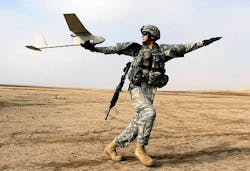Worldwide UAV and drone spending to more than triple over next decade, say Teal analysts
Military UAV research spending is likely to add another $30 billion in UAV spending over the next 10 years, Teal analysts say in the study entitled World Unmanned Aerial Vehicle Systems, Market Profile and Forecast 2015.
The 2015 study provides 10-year funding and production forecasts for a wide range of aerial drone payloads, including electro-optic/infrared sensors (EO/IR), synthetic aperture radars (SAR), signals intelligence (SIGINT), electronic warfare (EW), and command, control, communications, and intelligence (C4I) systems.
Spending for UAV payloads for C4I missions should double over the next decade, increasing from $3.1 billion this year to $6.4 billion in 2024.
New UAV sensor markets will see great increases as radio frequency (RF) systems supplant EO/IR capabilities, and next-generation UAVs at all scales require much more sophisticated -- and expensive -- sensors, analysts say.
Related: Should some smart munitions be classified as unmanned aerial vehicles (UAVs)?
"Rapidly increasing capabilities for RF sensors will be funded, as potential conflicts shift from clear-skies Central Asia to the more restrictive geographies of Eastern Europe and the Pacific," says David Rockwell, author of the electronics portion of the study. Out-years combat UAV and nano-UAV procurements will see much more expensive and capable sensors."
Military UAV spending will make up 72 percent of the market over the next decade, followed by 23 percent consumer, and 5 percent civil, analysts say.
Of the three areas, civil UAVs grow most rapidly over the forecast period as airspace around the world is opened, but it grows from a very low base. This year's study includes consumer UAVs for the first time because of their rapid growth and the blurring of the commercial and consumer markets, analysts say.
"The market for UAVs looks very strong, increasingly driven by new technologies such as the next generation of unmanned combat systems, and the development of new markets such as civil and consumer drones," says Philip Finnegan, Teal Group's director of corporate analysis and an author of the study. "Consumer UAVs are showing that they can do many of the easier commercial missions such as simple real estate photography."
Related: The future of military unmanned aircraft
The United States will represent the world's largest UAV market over the next decade, with 64 percent of total military worldwide research spending and about 38 percent of military UAV procurement, analysts say.
The study examines the worldwide requirements for UAVs, including UAV payloads and companies, and provides 10-year forecasts by country, region, and classes of UAVs.
The study covers almost 50 U.S., European, South African, and Israeli companies. UAVs are no longer of interest only to aerospace companies, but increasingly technology companies like Google, Facebook, and Amazon see a need to be in the market, analysts say.
For more information contact Teal Group online at www.tealgroup.com.
